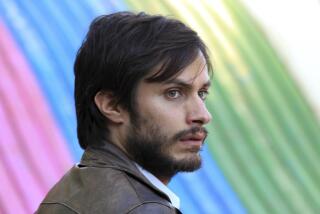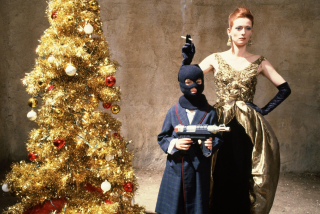Screening Room : Derek Jarman Retrospective Charts Artist’s Evolution
- Share via
The centerpieces of “Dancing on the Ledge: Derek Jarman,” a retrospective starting today at the Nuart honoring the late British experimentalist, are his two final features, “Wittgenstein” (Tuesday through May 22) and “Blue” (May 22-25).
In his all-too-brief, courageous life and career as an artist and gay activist, Jarman moved way beyond the tediousness of his early Shakespeare-inspired films--”Jubilee (screening Monday) and “The Tempest” (screening Friday)--to an ever-increasing accessibility with no loss of his venturesome style.
Opening the series is one of his finest, “The Garden,” a dazzlingly surreal retelling of the story of Christ juxtaposed with the fate of a pair of gay young lovers, who are similarly crucified. Jarman’s images here are among his most glorious, celebrating the beauty of nature and the joy of being alive, ever at odds with the forces of a darkly repressive society. It will be shown with his most widely distributed film, “Edward II,” a modern-dress version of Christopher Marlowe’s Elizabethan tragedy that he has transformed into a timely, fiery attack on homophobia.
Actually, the beautifully acted “Wittgenstein,” Jarman’s sprightly, witty 75-minute gloss on the life of philosopher Ludwig Wittgenstein, is among his most accessible films. In minimalist settings, Jarman sketches the influential philosopher’s life in a series of key encounters as we see him move from his native Vienna, where he was born into wealth in 1889, out into the world, principally Cambridge, where he sparred with Bertrand Russell (Michael Gough) and was nurtured by a fellow gay, economist John Maynard Keynes (John Quentin). In essence, we witness Wittgenstein (Karl Johnson) engage in a lifelong battle with the tantalizing limitations and possibilities of language in relation to philosophy. As for his own homosexuality, Wittgenstein found his desire to be open about his life at war with the need for secrecy because of the oppressive laws of his era.
As the ravages of AIDS, which claimed Jarman’s life Feb. 19, began to rob this most visual of filmmakers of his sight, he took on the most formidable challenge imaginable: to make a movie that would be entirely aural except that the screen would stay a sky blue--for 76 minutes. Jarman may have lost his sight but not his vision, for “Blue” is amazingly involving, an oratorio of soaring and richly varied sound and music as well as prose that verges on the poetic. Jarman charts the progress of his terminal illness with a terse, clinical detachment; these diary-like remarks punctuate an impassioned celebration of life and love in the face of a forthrightly accepted impending death.
Filmforum will sponsor a program of Jarman short films made in the late ‘70s and early ‘80s Sunday at the Nuart at 4 p.m. and again at 7:15 p.m. Although vibrant and watchable, they are surprisingly typical of much experimental work, collages with lots of stop motion, layered and fragmented images. The most distinctive and ambitious of the group, “The Dream Machine” (1984), is a determinedly pagan homage to gay love as a young man is gradually transformed into a glittery angel with filigree wings. It has been described as “a meditation on the works of William S. Burrough and Brion Gysin,” and it resembles nothing so much as the sweetly campy underground films of Jack Smith.
Among the other notable Jarman films screening are his 1966 debut feature “Sebastaine,” a retelling of the martyrdom of St. Sebastaine with much nudity--and in Latin! (Friday at 5:45 and 9:15); “Caravaggio” (Saturday at 4 and 7:45), a highly idiosyncratic tribute to the 16th Century gay artist; and “The Last of England” (Monday at 5:45 and 9:30), an apocalyptic, surreal vision of Britain after the fall of government that expresses a deep love of his country and its people.
* The films of Derek Jarman, through May 25 at the Nuart, 11272 Santa Monica Blvd., West Los Angeles. (310) 478-6379.
More to Read
Only good movies
Get the Indie Focus newsletter, Mark Olsen's weekly guide to the world of cinema.
You may occasionally receive promotional content from the Los Angeles Times.










